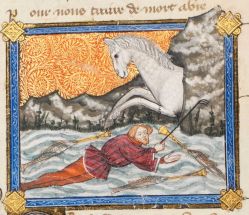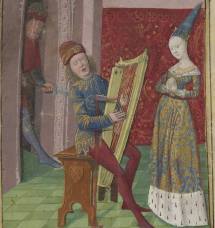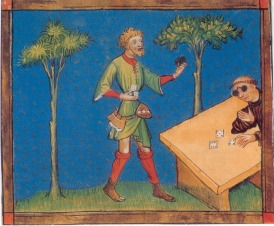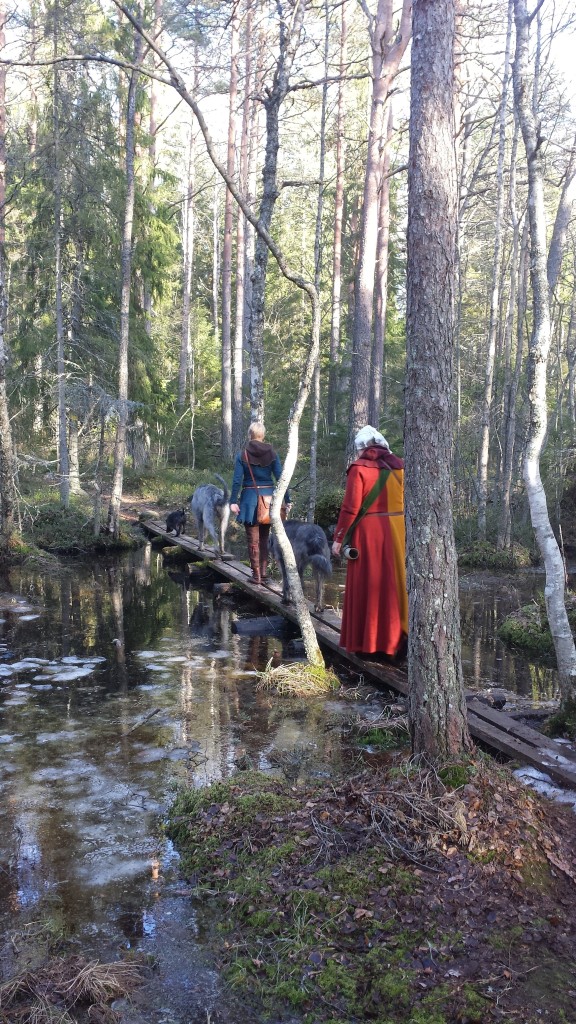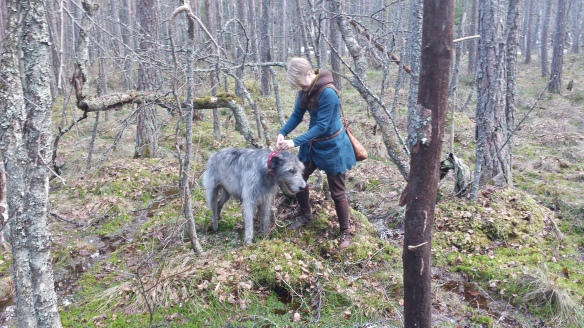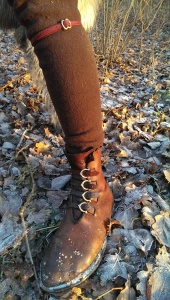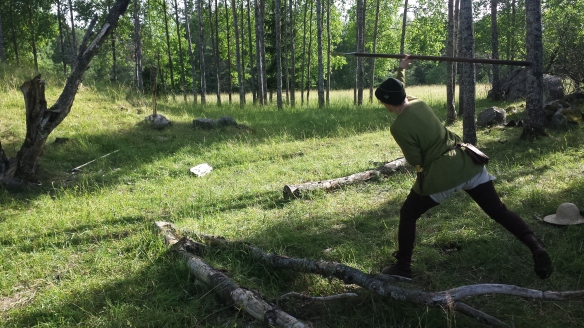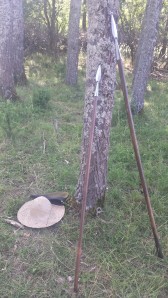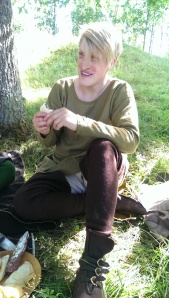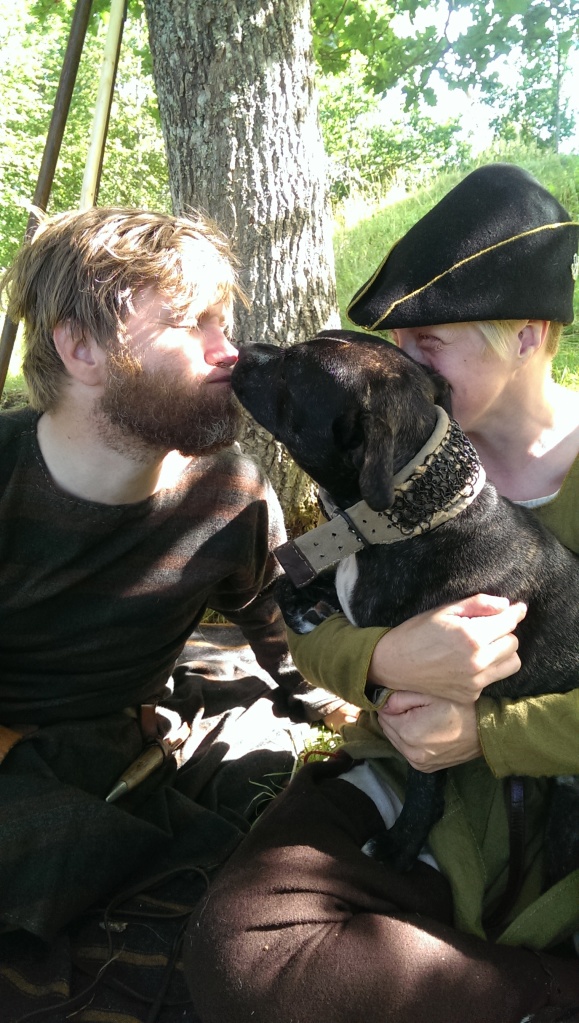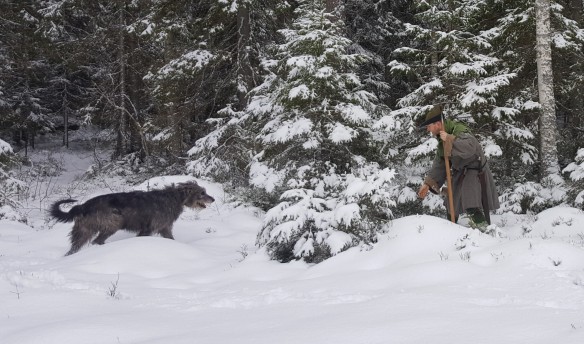 Hunting wolf in 14th century was mostly considered something you had to do. Pestcontrol. The wolf was not considered a noble animal, and its by-name (Noanamn) in swedish was ‘varg’ who’s original meaning was thief, or a generally bad person (a ‘Kasevarg’ was an arsonist). By-names was used for creatures that was feared, as using its real name supposedly would make it take notice and come to your farm and you wanted to avoid that. Hence, it is called ‘varg’ (thief) instead of its real name, Ulv. These days it is generally known as varg (better not take any chances still, eh?).
Hunting wolf in 14th century was mostly considered something you had to do. Pestcontrol. The wolf was not considered a noble animal, and its by-name (Noanamn) in swedish was ‘varg’ who’s original meaning was thief, or a generally bad person (a ‘Kasevarg’ was an arsonist). By-names was used for creatures that was feared, as using its real name supposedly would make it take notice and come to your farm and you wanted to avoid that. Hence, it is called ‘varg’ (thief) instead of its real name, Ulv. These days it is generally known as varg (better not take any chances still, eh?).
‘Being hanged with wolves’ was a shameful way to be executed where you were hanged on the same gibbet as wolfs.
Edwards has some things to say about the wolf in his Master of game.
..and evil they be and strong, for some- times a wolf will slay a cow or a mare and he hath great strength in his mouth. Sometime he will bear in his mouth a goat or a sheep or a young hog and not touch the ground (with it), and shall run so fast with it that unless mastiffs or men on horseback happen to run before him neither the shepherds nor no other man on foot will ever overtake him. They live on all manner of flesh and on all carrion and all kinds of vermin. And they live not long for they live not more than thirteen or fourteen years. Their biting is evil and venomous on account of the toads and other vermin that they eat.
So, hunting wolf is not considered a noble hunt, but more a hunt out of necessity. Therefor there was no rules to the hunt, they could be hunted with nets, traps, poison, dogs, spikes in meat, or, if you liked, par force. According to the Book of St. Albans, the wolf was hunted from the Nativity of the Virgin Mary (September 8) to the Annunciation (March 25), making this a winterhunt.
On the other hand. In his treaty of hunting from 1330, Twiti states the wolf as one of the few animals that you blow the Meneé for, and both the male and the female wolf to boot! This duality in looking at the wolf is probably because it is a difficult animal to hunt par force, i deserves rescpet for being hard to hubnt, even if it is considered pestcontrol. The meneé is of course only blown when the wolf is hunted par force.
Men take them beyond the sea with hounds and greyhounds with nets and with cords, but when he is taken in nets or cords he cutteth them wonderfully fast with his teeth unless men get quickly to him to slay him. Also men take them within pits and with needles and with haussepieds or with veno- mous powders that men give them in flesh, and in many other manners.
Traps
The traps depicted are often quite elaborate, which stands in opposition to some hunters saying that wolves do not return to a place where men have baited.
When men lay trains to acharne (with flesh) so as to take them, they will rarely come again to the place where men have put the flesh, especially old wolves, leastways not the first time that they should eat. But if they have eaten two or three times, and they are assured that no one will do them harm, then sometimes they will abide

 The traps shown are ones that are recommended in huntbooks though, the ones above being from Livre de chasse.
The traps shown are ones that are recommended in huntbooks though, the ones above being from Livre de chasse.
 Netting was a preferred way, in Swedish lawbooks the farmers were supposed to have a certain length of wolfnets prepared and was obliged to partake in wolfhunts when ordered to by the king or his appointed local men. The farmers then connected each length to each other making the whole parish combined wolfnet.
Netting was a preferred way, in Swedish lawbooks the farmers were supposed to have a certain length of wolfnets prepared and was obliged to partake in wolfhunts when ordered to by the king or his appointed local men. The farmers then connected each length to each other making the whole parish combined wolfnet.
Getting geared
Clothing
 As said before, the wolfhunt was a winterhunt, and when hunting in wintertime, grey clothing was preferred (as we have taken a look at here). Probably due to its camouflaging factors. In the pictorial evidence, in most wolfhunts they are wearing other clothes than grey, but… people did as they pleased even then.
As said before, the wolfhunt was a winterhunt, and when hunting in wintertime, grey clothing was preferred (as we have taken a look at here). Probably due to its camouflaging factors. In the pictorial evidence, in most wolfhunts they are wearing other clothes than grey, but… people did as they pleased even then.
The other clothes I used during this little outing was green, as this is the preferred colour during summer. The good old bycocket hat, as seems very popular amongst hunters, also got to be taken out for a little ride.
More on hunters clothing in general can be read here .
The dog
Not all dogs was suitable for wolfhunting. The wolf is a fast animal, and will outrun most dogs. And also uses hiding as a way to escape.
When he is long hunted with running hounds he fleeth but little from them, but if the greyhounds or other hounds press him, he fleeth all the covert as a boar does and commonly he runs by the high ways
the wolf also measures the mettle of the dogs set on him, and if they are not courageous enough it will scarcely bother about them. This gave rise to special woulfhoundbreeds of greyhounds.
When men let run greyhounds at a wolf he turns to look at them, and when he seeth them he knoweth which will take him, and then he hasteneth to go while he can, and if they be greyhounds which dare not take him, the wolf knows at once, and then he will not hasten at his first going.
Wolfhounds have been known to be able to single-handedly take down a wolf. Usually by running just as fast and tackle them. Then keeping them at bay by fast attacks to the abdomen. But being tackled by a 75 kilo dog and going down in speeds around 60 km/h is rather a tumbling experience in it self.
The wolfcollar The spiked wolfcollar is iconic and has been in use for a long time. There are several depictions of it from medieval times, and also a preserved Viking age spiked collar from Uppland, Sweden, that we wrote about here.
The spiked wolfcollar is iconic and has been in use for a long time. There are several depictions of it from medieval times, and also a preserved Viking age spiked collar from Uppland, Sweden, that we wrote about here.  The purpose of this spiked collar is to prevent the wolf from getting its jaws around the neck of the hound to bite it. The added bell makes it easier to follow the dogs movements in dense terrain. The spikes does not have to be overly sharp as they will do their job just as well by just being there.
The purpose of this spiked collar is to prevent the wolf from getting its jaws around the neck of the hound to bite it. The added bell makes it easier to follow the dogs movements in dense terrain. The spikes does not have to be overly sharp as they will do their job just as well by just being there.
Weapons
 This wolfhunter carries a javelin and a sword. The sword in this case being of the Falchion type.
This wolfhunter carries a javelin and a sword. The sword in this case being of the Falchion type.
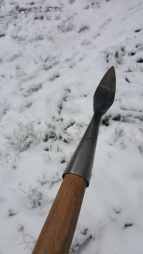 The javelin had, by the 14th century, mostly been reduced to a huntingweapon. As such it is fairly common it seems and it is almost always carried in wolfhunts. The head of the javelins are most often leafshaped and very few have barbs, as one might have expected them to have. I am not sure why this is the case, a javelin that sticks to its target would be better in slowing a target, but it is possible that reuse of the javelin was considered, as it could be picked up and thrown again. To get more information about our thoughts on the javelin, i recomend you to read this.
The javelin had, by the 14th century, mostly been reduced to a huntingweapon. As such it is fairly common it seems and it is almost always carried in wolfhunts. The head of the javelins are most often leafshaped and very few have barbs, as one might have expected them to have. I am not sure why this is the case, a javelin that sticks to its target would be better in slowing a target, but it is possible that reuse of the javelin was considered, as it could be picked up and thrown again. To get more information about our thoughts on the javelin, i recomend you to read this.
The sword was carried as the main means to kill the prey. After the dogs had catched it, it was killed, and this, the ‘Mort’ was almost always delivered with a sword. Armingswords, long Basilardas, and also falchions are seen brought into the hunt. Stabbing swords are more useful with killing animals, so I am not sure what the falchion, being mainly a cutting weapon, would be good for. but… there it is. 
The hanging of most swords, and therefore also the falchion, in later 14th century is often very simple. A loop from the scabbard that goes around the belt.
Horn and leash.
The horn is of course carried as it is the main means of communications during hunts. The Mort is also blown when the beast is killed. It seems it was considered worthy of such honour.
 The leash is sometimes seen as carried on the horn when not in use. It is suspended from the crossknot of the hornbaldric.
The leash is sometimes seen as carried on the horn when not in use. It is suspended from the crossknot of the hornbaldric. 
The quotes above is all taken from ‘The master of game’, by Edward of Norwich, and the pictures from ‘Livre de chasse’ by Gaston Phoebus. Both BF and Morgan version is used. 





